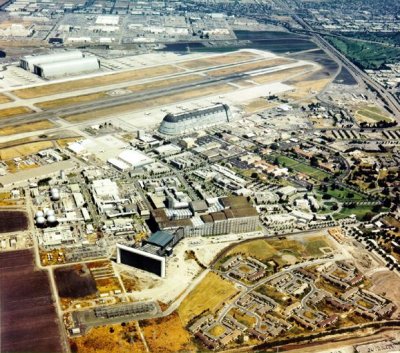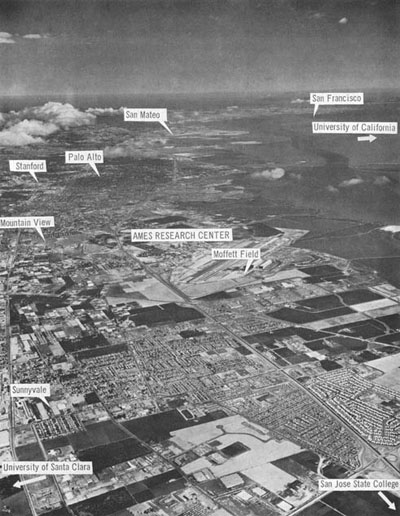NASA Ames Research Center

Aerial view of Ames Research Center and Moffett Field. Credit: NASA.

San Francisco Bay region circa 1964. Credit: NASA.
Ames Research Center (ARC) is a facility that for more than five decades has pioneered work in astrobiology, and
also researched other new techniques and technologies of potential use to NASA.
Located at Moffett Field in the heart of California's Silicon Valley, Ames
was founded on 20 December 1939, as an aircraft research laboratory by the National Advisory Committee on Aeronautics (NACA). In 1958, it became part of the National Aeronautics and Space Administration
and in 1960 the site of NASA's first life sciences laboratory, set up to
study prebiological development, the conditions under which life might survive,
and a variety of related issues. Thus Ames was established as the center
for NASA's astrobiology program, first under Harold P. Klein and then under Richard S. Young. Cyril Ponnamperuma,
a student of Melvin Calvin, joined as a
research associate and eventually headed a branch in chemical evolution.
It was Ponnamperuma's group that confirmed the existence of extraterrestrial amino acids in the Murchison
meteorite.
Following an earlier request by NASA to scientists around the country for proposals for ideas for remote life-detection equipment to be used in the search for possible martian life, Ames set up a team in 1963 to evaluate the various concepts.1 Subsequently, it played a major role in the Viking program, with Klein in charge of the mission's biology science team.
The involvement of Ames in SETI stemmed from John Billingham, head of the center's Biotechnology Division, who in 1970 convinced Ames Director Hans Mark that a small-scale study of the problems of interstellar communication was justified. This led, the following year, to the proposal for Project Cyclops. Eventually, a less ambitious scheme was developed jointly by Ames and the Jet Propulsion Laboratory known as the High Resolution Microwave Survey, the targeted portion of which was the responsibility of Ames.
Several interplanetary missions have been operated by Ames, including Pioneer 10 and Pioneer 11, and the center now manages the newly established Astrobiology Institute. Recently, researchers at Ames created cell-like bubbles in a laboratory simulation of an interstellar molecular cloud (see life, origin) and reported finding evidence of polycyclic aromatic hydrocarbons in space. See also Human Research Facility (HRF).
Moffett Federal Airfield
Moffett Federal Airfield is a facility created in 1994, operated by NASA, and based on the old Naval Air Station Moffett Facility, near Mountain View, California. Moffett Federal Airfield is adjacent to the Ames Research Center.
References
1. Quimby, F. H. Concepts for Detection of Extraterrestrial Life,
NASA Document SP-56, Washington, D.C.: US Government Printing Office
(1964).
2. Muenger, Elizabeth A. Searching the Horizon: A History of the
Ames Research Center, 1940–1976, Washington, D.C.: NASA SP–4304,
1985, 12–14, 67–68, 131–132.


